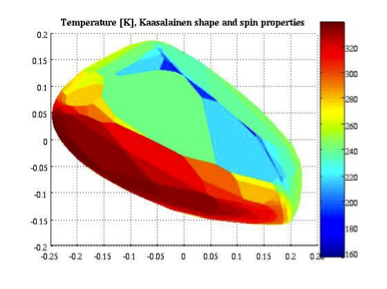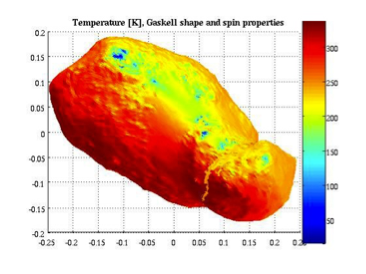Radiometry
Radiometry is a powerful technique to derive size, albedo, and thermal properties from thermal infrared measurements.
The radiometric technique consists in the exploitation of thermal data in the mid- and far-infrared (obtained from space) and data in the visible (obtained mainly from the ground). The three main methods to obtain size and albedo of asteroids using radiometric techniques are: the Standard Thermal Model (STM), the Fast Rotating Thermal Model (FRM), and the near-Earth asteroid thermal model (NEATM). Assumptions involved in the use of thermal models cause the resulting asteroid diameters and albedos to be model dependent and affected by uncertainties. Also, the flux variability due to asteroid irregular shape and rotation alters the mean intensity of the measured spectral energy distribution. The appropriate wavelength for observations depends on the surface temperature of the studied body. Main belt asteroid surfaces are around 300 K and are best observed at around 10 µm, TNOs surfaces are at around 30 - 40 K so the best wavelength range to observe them is between 70 to 100 µm. The size, albedo and thermal properties are obtained through thermo-physical models (see Müller et al.: "TNOs are Cool'': A survey of the trans-Neptunian region. I. Results from the Herschel science demonstration phase", A&A 518, 146 (2010) and references therein for instance) to fit both the data from the space and from the ground. The radiometric technique is not too sensitive to the exact shape and provides sizes and albedos with around 10% accuracy in the most favourable cases. It is the most productive way of determining sizes and albedos (it also provides surface properties such as thermal inertia and roughness). The "TNOs-are-cool" Herschel Key project (the largest Herschel project with more tan 370 h of granted time) has gathered thermal data for more than 130 TNOs (Müller et al.: "TNOs are Cool: A Survey of the Transneptunian Region", EM&P 105, 209 (2009); Kiss et al.: "A portrait of the extreme solar system object 2012 DR30", A&A 555, 3 (2013)). A good example of capabilities of the radiometric method with Herschel observations is one very distant (88 AU) TNO named Sedna that for the first time has a size estimated with reasonable precision. Its diameter is 995 +/- 80 km and geometric albedo is 0.32 +/- 0.06 (Pál et al.: "TNOs are Cool: A survey of the trans-Neptunian region. VII. Size and surface characteristics of (90377) Sedna and 2010 EK139", A&A 541, 6 (2012)).


Comparison of the shape model for Itokawa with 204 facets (left) from lightcurve inversion technique, and a much more detailed shape model with 49152 facets (right) based on in-situ measurements from the Hayabusa mission. Figure and thermo-physical model adapted from Müller et al.: "(25143) Itokawa: The power of radiometric techniques for the interpretation of remote thermal observations in the light of the Hayabusa rendezvous results", PASJ 66, 52 (2014).
